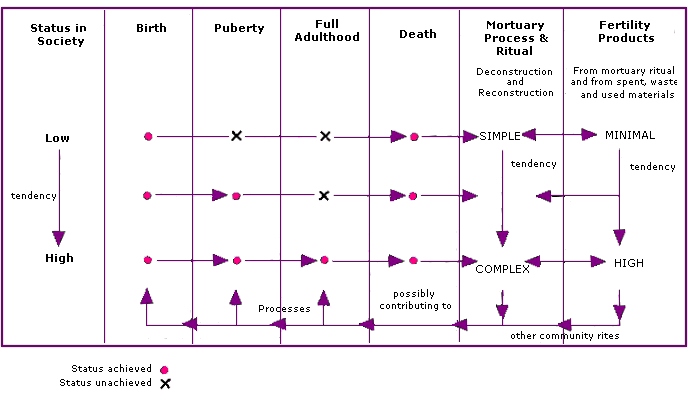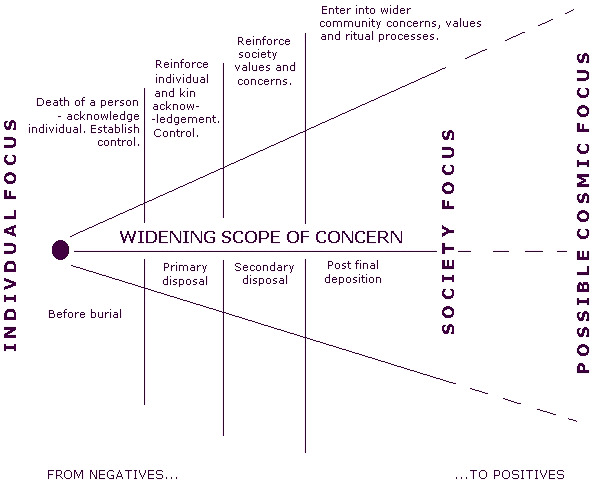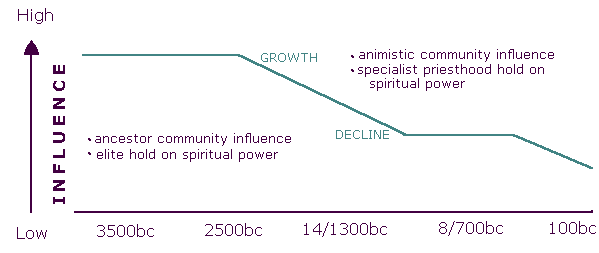
Figure 9.4-1: A general model of mortuary process
From 3500bc to AD43 human death appears to have been treated as a rite of passage in southern Britain in a consistent way, inasmuch as a process of mortuary ritual appears to have been followed with high degrees of consistency in all three geographical areas compared. There might be slight local variations in process from time to time, and difference of emphasis in the detail, but it is possible to build an underlying general model to which all areas might be seen to adhere. Figure 9.4-1 focuses on the mortuary ritual, and shows how dimensions of individuals' status in the community, and their reaching an age which might have embraced one or more of the rites of passage of birth, puberty, mature adulthood (which for many would have included marriage), and death seem likely to have been inter-related over this period. Their progress through life rites, and their status (derived from various criteria) appear to have impacted on the complexity of mortuary ritual, and on their potential usefulness to society as promoters of its well-being after their death.
The dual purpose of mortuary and related ritual for these peoples, consistently through the whole period under review, was to send the dead person's soul to rest and to turn the negatives of their death into positives for the surviving community. The perceived negatives prompted many means of control and aversion in the mortuary process, especially in the earlier stages, and focused on the dead individual, the soul and its passage onwards. The positive ends centred on the use of the depersonalised remains, particularly in the later stages in various ways, and focused on the community good. In these later stages, body parts might be used either exclusively or in association, and especially in the latter case with selections and collections of other material for wider purposes.

Figure 9.4-1: A general model of mortuary process
The model in Figure 9.4-1 links mortuary process with a high-level purpose that was through the whole of 3500bc-AD43 associated with it. Indeed mortuary process at a certain point shades into or combines with wider ritual activity for the community, aimed at its preservation and growth. The model implies that every human disposal might receive mortuary treatment on a spectrum from the very simple to the very complex (which is seen in the record), and suggests that a combination of factors would determine the treatment used. Underlying the model is thought and attitude which acknowledge that the individual's place in life might be related to the use to which that individual was put after death. Thus on the model, a person dying young with lower status in society would be of lower value in terms of investment of mortuary ritual (including associated burial items). A person of mature years, with high social standing, would be worth high investment in mortuary ritual (including monumental and associated burial items). A spectrum exists in between. The model therefore implies a very structured approach among the prehistoric peoples of southern Britain in attitudes to disposal, and to the potential value that could be extracted from mortuary and connected processes.
It is, however, just a model. There is sufficient evidence to justify its building, since there are many disposals and circumstances which fit its implied spectrum and which can be explained by it: there are also ambivalent or unascribable cases which do not assist it.
The second model, set out in Figure 9.4-2, elaborates on the idea of gradual widening of the focus of the objectives of mortuary process to broader social ones. It is suggested that the evidence follows a pattern moving from focus on the individual to focus on the remains as a community property for use in more general ritual contexts, most frequently centring on fertility and survival. In the various transfer processes which have been identified in the record, the individual by each movement loses identity as a person, and moves into a state of impersonality in which the remains can be used by the surviving society. The remains may be combined in presumably powerful associations to obtain the benefit that the community seeks in a wider ritual to that end. They may be saved, saved and spent, reused and so on, as long as the community judges there is value in the process. The end may be final deposition (by then probably of a fragment or fragments unattributable to the original owner), loss or discard. This model would fit with an anthropological concept among some peoples that ultimately the dead join the cosmos, submerging with the elements of the world (or nature, or whatever image the people who believe this have of the destiny of the attenuating dead person), and fading into the world around. There is no evidence that the peoples of southern Britain thought in this way, but there is evidence that eventually some human bone became lodged in unstructured and casual ways in the living environment, as if it no longer held interest or associations for the community and was unregarded. This suggests that a point was reached in their belief system when human remains were spent forces, by inference from the intensity of activity that took place otherwise centred on such remains.
A more focused expression of this model is in Figure 9.4-3, which also relates to Figure 9.4-1. In this a death-transition-rebirth model is suggested which could explain much of the evidence for all periods, in which the individual dead move from being a threat, through a transition phase and depersonalisation, to being useful communal material for positive purposes.
The metaphor of this movement is expressed by the peoples of southern Britain over 3500bc-AD43 in using very complex physical transfers of mortuary and other materials between settlements, middens, excarnation sites, other sites and disposal sites in every period. The small models in Figure 9.4-4 illustrate transfer movements observed in the research between settlements, primary and secondary disposal sites and midden sites. The beliefs underlying such movement have been referred to before. It is argued here that the evidence of this research supports the view that prehistoric southern Britons shared them, and that they encompass not just beliefs about afterlife, but about an otherworld which is capable of helping a community which acknowledges it and observes its requirements. A point to be added is that these models are derived just from human mortuary contexts and a small number of non-mortuary sites: there is much scope to supplement them with material derived from non-human mortuary sites (animal whole and part disposals, for example), and sites with other types of deposit. The wider ritual referred to above might be exposed the more thereby.


Figure 9.4-3: From individual to communal role
These models provide the components of a general framework of attitudes to disposal of the dead. The section began by relating disposal data, evidence and theory to purpose, and thence to four major behavioural contexts which linked with phases of disposal process. These four contexts were the foci for propositions to be examined, and centred on discerning what behaviour was oriented to the present community, to status, to the ancestral community and to beliefs (see Figure 9.3-1).
It became evident in examining the hypotheses of each proposition that activity often served more than one context, especially as the mortuary process moved on, and that in many cases the process went beyond the elementary demands of disposal of remains. This led to development of the general models above. It has also become clear through both the examination of hypotheses, and through the general research process, that at times the activity in the model is transacted with varying emphases at different times over 3500bc-AD43, and that shifts occur. The following section concludes the research by reviewing the major variations.
Periodic variations and trends in attitudes which flex the general model
While there is no evidence that attention to the community of ancestors fades out at any time, the visible signs of such attention (for example prominent monuments, and bone manipulation at disposal sites) reduce from 14/1300-8/700bc, and never recover to the level of 3500-14/1300bc. It would appear from mortuary evidence that a relatively simple economy and perhaps more segregated community organisation of 3500-2500bc was overtaken from 2500bc by initiation of both a more complex economy (stimulated by technological development among other factors), and a more complex set of communities on their first steps towards integration. Conventional interpretation of the period from 14/1300bc is that economic pressures became greater as the population grew, and that clear definition of territorial boundaries became more critical. The communal ancestral burial places, perhaps allied with references to natural features such as rivers, had sufficed until then to show these boundaries, but by 14/1300bc less ambiguous alternatives were needed and ranch boundaries were excavated to help to define land holdings. Sole reliance on the power of ancestral authority was de facto reduced, and the responsibility to protect territory shifted more directly onto the controlling elite of the communities who sought recourse to other means.
It is in this period and the next (8/700-100bc) that grave goods of excellence reduce in the burial record. The use of pits as the receptors for burial simultaneously increases. It is also in these two periods that hoards of bronze and later ironwork emerge in the general archaeological record, and the deposits of rich goods occur in rivers and other watery boundaries (Bradley 1990). These rich deposits, buried in the earth and cast into in rivers, may have a connection with the changes in the burial record and with the socio-economic changes posited. It would fit with the suggested change, if the elite had begun to entrust their wealth not to their ancestors' graves, as in the past, but to other powers that protected their boundaries and that guaranteed the fertility of their crops and peoples. The places for these rich gifts move away from lineage graves to where the other powers are perceived to exist, below the surface of the water, and below the earth. The one protects the community's possession of the land, the other produces fertility in the land. A society under pressure economically looks to both, needing to control boundaries and the fertility of the soil enclosed (Cunliffe pers. comm.).
The belief shift is therefore seen to be from that primarily focused on an ancestor community that could guarantee both territory and fertility, to one more overtly supporting an otherworld community of spirits that might more reliably do this in future. This model assumes that the ancestor community's potency was still believed in, and was used thereafter in more specific contexts, as the strong preoccupation with skull use shows (Table 9.6-5) and as the transfer activities suggest. The model does not assume any change in beliefs about the mortuary process itself, the progress and destiny of the soul, or about the essential nature of the ancestor community, since there is no evidence to suggest such change. Variation is in the working context of ritual.
The model also assumes that the otherworld community of spirits had been nurtured in previous periods (as witness, for example, the rich variety of pit activity), and that the shift raises their profile in ritual rather than invents them. The emergence of monuments in 2500-14/1300bc connected with both mortuary deposits and other wider ritual, and of shrines in settlements, might both be early indicators of the shift in belief which is suggested here to have started in earnest at some time after 14/1300bc. For the more general community need and from a certain point in prehistory in southern Britain, the power of ancestors might have been perceived by the elite and their community as needing supplementation from other sources, and this led to the posited change in belief, and in the changed behaviour which is implied in the archaeological record.
This decline in the use of ancestors to display lineage, boundaries and power by the Late Bronze Age and the Early Iron Age may have found its counterpoint in the development of hill forts (Cunliffe pers comm). These displayed the power of the elite by their monumentality, and appear to have developed, at least in a few cases, as the centres of organised community activity, ranging from the economic and secular to the mortuary and religious. Some of these hill forts provide intense foci of activity centring on human remains, which go beyond simple functional concerns of disposal process and into complex ritual most readily explained as aimed at ensuring the future fertility of the community, its crops and stock. Some of what previously had taken place at ancestors' burial sites and related structures such as causewayed enclosures, on more transient settlements of the earlier past, and on the more established settlements of the nearer past is encapsulated on some (not all) of these monuments. It is indeed important to note that there is evidence for process of the hill fort type both at small settlements, and at disposal and non-disposal sites of the past. It is may be slight, but it exists, and some imbalance of the archaeological record may have to be taken into account. Application of the methods of retrieval and analysis used at 1198 Danebury to sites of the past might have evened the balance, and the richness of discovery at the former should help to piece together what might have been the case at other sites which were less extensively and demandingly excavated rather than less well endowed.
The suggested shift from 14/1300bc away from dependence on the ancestor community may have had the effect of initiating a division of power between the secular rulers and spiritual leaders in the community. This perhaps took many centuries to take full effect in the form of a recognised community of priests such as the Druidic sect mentioned by Classical authors. There is no evidence to support this proposition, except inference from the occurrence of shrines as AD43 approaches, and it depends on assuming that the secular rulers perhaps gradually accepted that intercession and relationships with otherworld powers could be carried out by a specialist group skilled at such activity. The political implications of this concession for the power of ancestors and for the power of the secular elite would have been considerable. There is a hint that this might have been the case in Classical references to the influence of the Druids in the 1st century BC with the southern British tribal rulers. There is evidence that the Roman Empire took the influence seriously, judging by its efforts to reduce the impact of the sect in Britain and in Gaul.

Figure 9.4-5: Outline model of ancestor/elite/religion/priesthood influences
There are only these tenuous pieces of evidence to suggest that, as ancestor devotion lowered its profile, a more general religion grew that focused on an animistic religion. This could have developed into the Celtic religion's preoccupation with spirits of place and space, and would fit with the outline model illustrated in Figure 9.4-5.
Finally, while the search for an elite ended with the conclusion that they were identifiable, it also speculated upon the existence of groups lower in the social order. The issue is whether there are clues to further economic subdivisions of society in any period. There was some slight evidence for individuals with special roles or stations in society that would need deeper investigation to test, and a possible but very putative secular/spiritual division within the elite group itself. No evidence has emerged for a possible grouping between the elite and the mass until the Late Iron Age, when flat cemeteries occur in the record, with inhumations accompanied by grave goods ranging from the modest to the moderately (but not very) wealthy. Alongside these in the same period are the continuing settlement burials and the few very wealthy graves. There therefore appears to have emerged a social class in between the two. Some of these sites were close to trading centres the establishment of which grew with the influence of the Roman Empire. While trade between southern Britain and mainland Europe was carried on in periods before the Late Iron Age, the thrust of economic development had never seemingly been so focused as when the Roman Empire advanced closer. Indeed the infiltration of neighbouring economies was the subtler weapon used by Rome to gain influence beyond its borders, and eventually, if the effort was calculated as likely to be repaid, to gain control.
An attempt has been made through the process of this research to move from recorded and interpreted detail of excavation, and some anthropological theories on death as a rite of passage, to the building of theory (or models) of disposal process and connected beliefs for a calendrical period of c. 4300 years in prehistoric southern Britain. These models have been reached through the examination of issues arising from the analysis of disposal processes and characteristics, and construction and testing of hypotheses. The concluding thesis is that it is possible to recognise from evidence many of the attitudes to disposal of the dead in that period and region, to state that much ritual activity supporting the disposal process was practised as a tradition through 3500bc-AD43, and to recognise patterns of activity suggesting that disposal was treated as a rite of passage in much the same way as it was by many other peoples of the past and in the present. It is possible to go further and suggest that, on the evidence, in the minds of the peoples of southern Britain, mortuary ritual was integrated with wider rituals of society in those times, and describe to a degree in what way.
© Internet Archaeology/Author(s)
University of York legal statements | Terms and Conditions
| File last updated: Wed Nov 7 2001